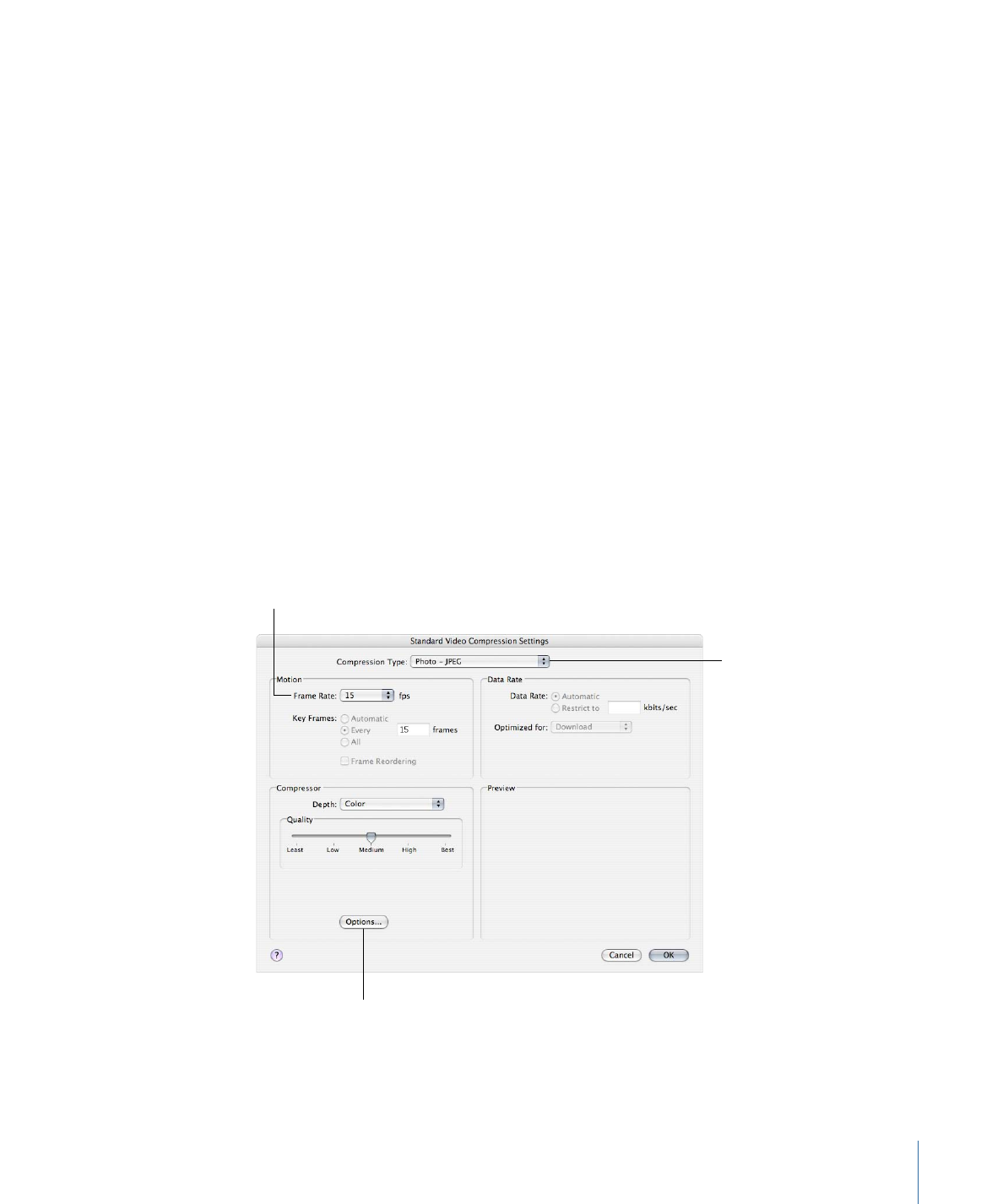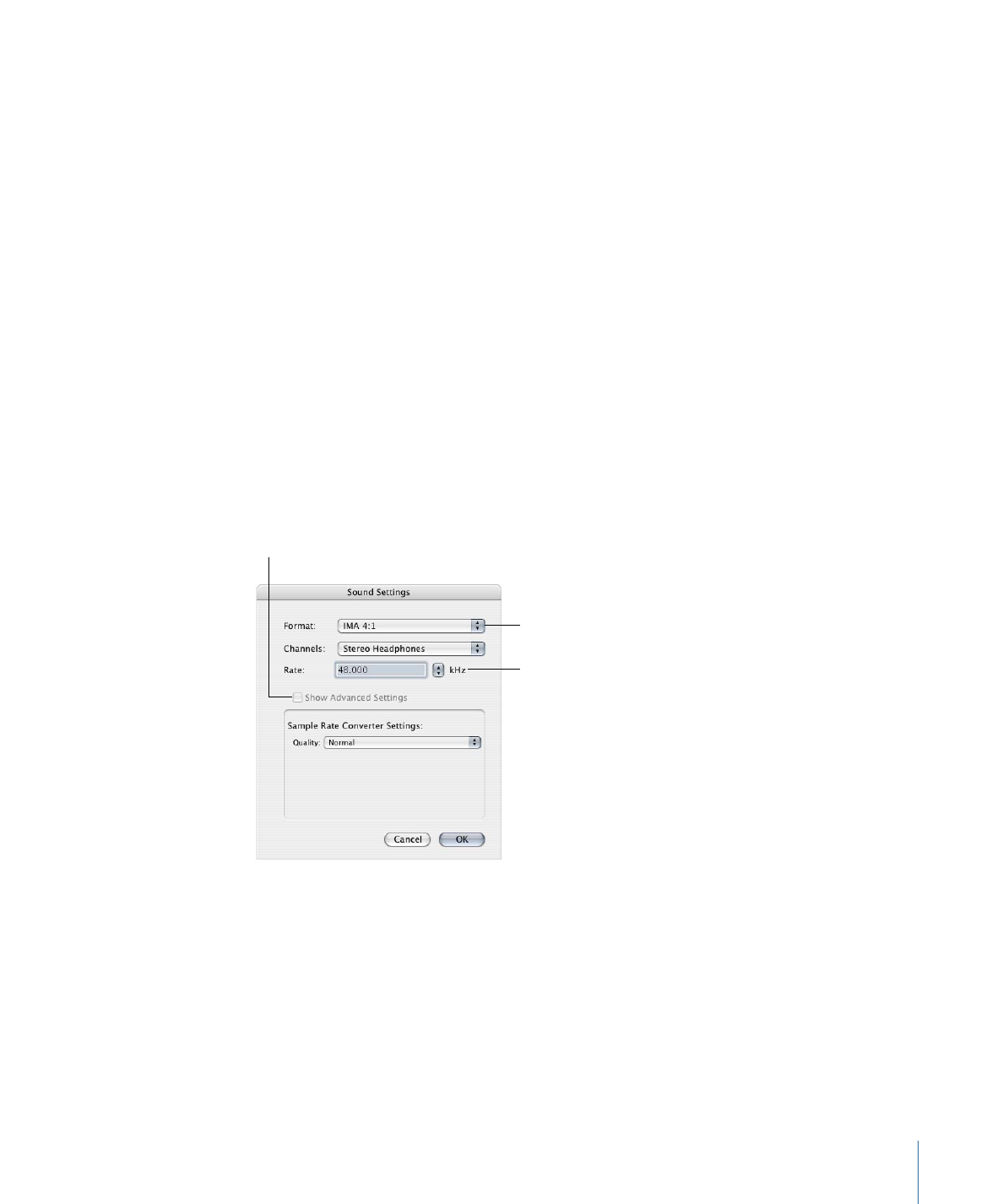
About the Compression Settings Dialog
You use the Compression Settings dialog to change your video codec settings for the
QuickTime output format. To open the Compression Settings dialog, click the Video
Settings button in the QuickTime Encoder pane.
If a particular setting can’t be changed, it remains dimmed. Some video codecs—such
as Photo-JPEG—allow you to make additional settings. If this is the case, the Options
button becomes available. Click it to make additional settings.
Choose a frame rate
from this pop-up menu.
Click the Options button for
more configuration settings.
Select a compression
type from this pop-up
menu.
The Compression Settings dialog contains the following items, depending on which codec
you choose in the Compression Type pop-up menu.
237
Chapter 21
Creating QuickTime Movie Output Files

Compression Selection
The compression selection, located at the top of the window, defines which settings are
active in the rest of the window.
• Compression Type: Use this pop-up menu to choose the video codec you want to add
to your preset.
Motion Area
The Motion area settings are only active for some codecs.
• Frame Rate: With this pop-up menu, you can reduce the frame rate of your original file
to reduce the size of the compressed file. Higher frame rates make for smoother motion
but require more bandwidth. You use the Frame Rate pop-up menu to choose a different
frame rate, but for best results you should change it to a number that the original file
can be easily divided by. For example, if your original file had a frame rate of 30 fps,
you should use a frame rate of 10 fps or 15 fps. Choosing a frame rate of something
like 24 fps would result in uneven motion and even dropped frames, because 30 is not
evenly divisible by 24. Choose from the following settings: 8, 10, 12, 15, 23.98, 24, 25,
29.97, 30, 59.94, 60 fps, or choose Custom to enter a number manually.
• Key Frames: If your selected codec allows it, use the Key Frames Every field to enter the
number of frames you want between your key frames. Codecs based on the temporal
compression method use key frames. These act as a reference frame for the next
sequence of frames, so that any data redundancy between the key frame and the
ensuing frames can be removed. In between key frames are the less detailed delta
frames. You need to insert key frames throughout your media file because content
changes. Some video codecs allow you to insert a key frame every certain number of
frames, while other video codecs use natural key frames by scanning the whole file to
detect where the major similarities and differences occur and inserting the key frames
accordingly.
If there’s a lot of motion in your media file, you need key frames more often than you
do with something more static, such as a talking head sequence.
Data Rate Area
The Data Rate area is only active for some codecs.
• Data Rate: Use this field to set the number of kilobytes per second (KB/sec.) required
to deliver your media file. This setting is useful if you have a specific bit rate (such as a
DSL connection) or amount of space (on a DVD or CD-ROM). You should choose a data
rate that is appropriate for your delivery medium and set it as high as possible within
your data limitations. When you set a data rate, you override other codec quality settings
because the codec compresses the file as much as it needs to based on its data rate
limit.
Remember that the data rate is only for the video track of a media file. If your media
file also contains audio, you must allow some space for that too.
238
Chapter 21
Creating QuickTime Movie Output Files

Compressor Area
The Compressor area changes based on the codec chosen with the Compression Type
pop-up menu.
• Options button: This button remains dimmed unless the codec you selected from the
Compression type pop-up menu offers options. It is recommended that you contact
the manufacturers of these codecs directly for more information about the additional
options they offer.
Preview Area
The Preview area is not used.